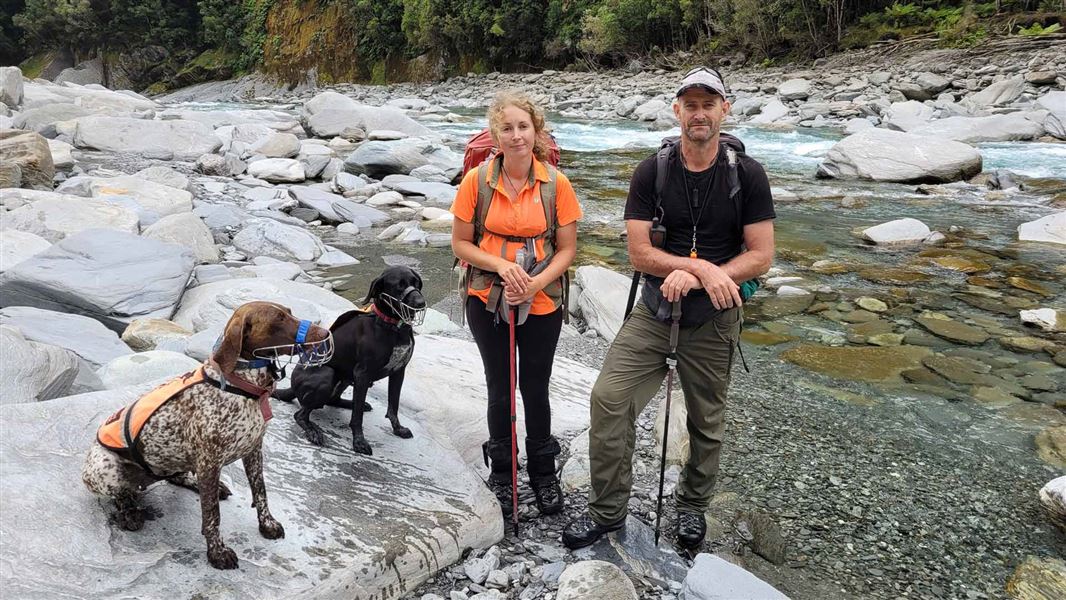Archived content: This media release was accurate on the date of publication.
Date: 20 March 2023
Whio/blue duck are river specialists, one of the few waterfowl worldwide that live year-round on fast-flowing rivers.
DOC Biodiversity Ranger Antje Wahlberg said the five-yearly census, carried out in each of the whio security sites around the country, is important for gauging numbers of the threatened-nationally vulnerable bird.
“The best time for doing whio surveys is either early morning or late evening when they’re more active and feeding on the river. Whio dogs, trained through our Conservation Dogs Programme, are crucial for the search.
“When it’s hotter during the middle of the day whio spend a lot of time roosting under large boulders so it’s easy to walk past without realising they’re there. The dogs really come into their own then as they can smell hidden birds and indicate to their handler that birds are nearby. A quick search with a headtorch under some boulders usually shows whio roosting in the dark.”
Dog handler teams checked the Styx, Arahura and Kawhaka river valleys as well as the Mingha in Arthur’s Pass, she says.
“The Arahura and Styx have had large floods and slips over the past four years so we were worried that pair numbers could be down significantly. However, we saw plenty of whio.
“In the Styx, seven confirmed pairs were found with several single birds seen too. Towards the end of the breeding season whio are less territorial so partners can be seen further apart from each other than earlier in summer. Several of the single birds seen were only a few hundred metres apart meaning another two to three pairs could be present in the area.”
Results in the Arahura were also similar to past years. Six pairs were confirmed between Harman Hut in the upper valley and the Cesspool near Milltown. Several single birds were also seen, representing a possible further three pairs.
Four to five pairs were seen on the Kawhaka River along the West Coast Wilderness Cycle Trail. One pair was spotted in the section of the Mingha that was checked. When the full Mingha was checked at the last census two pairs were found.
Three of the four dog handlers working on the census were DOC rangers, the other a private contractor experienced in whio survey work.
The census was supported by the Genesis Whio Forever programme.
DOC partners nationally with Genesis in Whio Forever. Since the partnership began in 2011 the number of whio pairs nationwide has increased from 298 to over 860.
Genesis’ General Manager Sustainability, Kate van Praagh, said it was great news the 2023 whio census had been such a success.
“Genesis relies on waterways to generate electricity through our hydro power schemes, and healthy whio populations are an indicator of healthy rivers.
“We’re proud to support DOC's work in growing and tracking whio numbers.”
Whio Forever is encouraging people to look out for whio this year. This could include spotting them in their natural habitat or helping with trapping or volunteering near known whio locations.
Further information
- With a population under 3000 the endangered whio needs our help so they can thrive in their environments.
- Whio are classified as nationally vulnerable. The population faces further decline due to threats such as predation and severe weather.
- The Isaac Conservation and Wildlife Trust rear whio for release into the wild at their captive breeding facility at Peacock Springs. Eggs, or newly-hatched chicks, from captive pairs held at Orana Wildlife Park, Willowbank Wildlife Reserve in Christchurch, and Kiwi Park Queenstown are sent to the breeding facility as part of the whio recovery programme managed in conjunction with DOC.
- Security sites are high priority sites intensively managed to secure representative populations of whio. At each of these the goal is to have 50 pairs of whio. There are four sites in the South Island and four in the North.
- Protected species detection dogs help DOC to manage populations of endangered species by locating, whio, for example, for monitoring, health checks, egg collection for hand rearing and translocate them to other areas.
Contact
For media enquiries contact:
Email: media@doc.govt.nz
